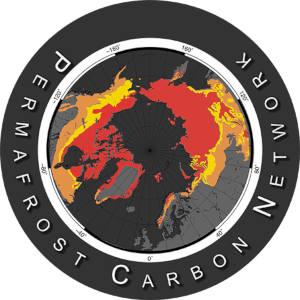1) Arctic Carbon Exchange:
1a) The first workshop to 'Reconcile historical and contemporary trends in terrestrial carbon exchange of the northern permafrost-zone' was held April 28-30, 2018, in Santa Barbara, CA.

The overall goal of this core synthesis activity of the PCN is to assemble data products of high latitude permafrost CO2 flux measurements to get an updated view of how carbon balance in these systems has changed over time.
Four scoping documents were developed during the workshop and are available on Google Drive for members of the PCN. The topics and working groups are: WG1) Site lists and visualization tools; WG2) Metadata; WG3) Spatial and temporal scaling; WG4) Economic analysis of an Arctic carbon emission monitoring network.
The next workshop will be held in October of 2018. More details about the Arctic Data Center activities are available here.
1b) Participate in survey for CO2 flux chambers: Working Group 3 of the Arctic Data Center Activity is conducting a survey for CO2 flux chamber researchers to get an overview of the chamber net ecosystem exchange data availability for the permafrost zone and spatial and temporal coverage of the measurements. Please consider contributing by taking this 5 minute survey: https://goo.gl/forms/ClodR3v7iSJk2kiR2
Thank you for your help! Anna Virkkala, Marguerite Mauritz and other members of the CO2 synthesis group
2) Virtual Meeting of the Permafrost Carbon Network: On June 20, we held a virtual meeting with synthesis leads to discuss updates on syntheses, emerging ideas and upcoming events. A lot of good progress has happened since AGU amongst other things with the following synthesis topics: 1) Thermokarst, 2) Arctic Carbon Exchange, 3) Data-Model comparison, 4) Vegetation and Temperature synthesis, 5) Permafrost Microbiome, 6) Subsea permafrost. We have posted the slide updates on our shared Google Drive. You can view the slides under this link.
3) Session at AGU 2018: We are hosting again a session on 'B096: Vulnerability of Permafrost Carbon to Climate Change' at AGU and encourage you to submit your abstracts to our session.
Session Details: Permafrost zone soils contain 1330-1580 Pg of organic carbon (C). Permafrost degradation can decrease ecosystem C storage by enhancing microbial activity and ecosystem respiration, but can also stimulate plant growth and lateral C flux, potentially increasing C stored in vegetation, soil, and sediment. This session invites papers that examine factors causing losses and gains in ecosystem C storage that relate to the question: What is the magnitude, timing, and form of C release from permafrost zone ecosystems to the atmosphere in a changing climate? Papers may address any aspect of this topic from molecular to global scales, using measurements or modeling to detect or forecast permafrost thaw and its influence on the C cycle and climate.
Session conveners: Christina Schaedel, Jessica Ernakovich, and Ted Schuur
Abstract submission deadline is August 1, 2018,11:59 PM EDT
4) 8th Annual Meeting of the Permafrost Carbon Network: We will host our all scientist meeting the Sunday before AGU in Washington, DC (December 9, 2018). More details in regard to the agenda and meeting location will follow in the fall.
5) Submission deadline for papers to be included in IPCC SROCC: The cutoff date for publications to be included in IPCC's Special Report on the Ocean and Cryosphere in a Changing Climate (SROCC) is October 15, 2018.
6) Some recent publications:
Franz D, Mammarella I, Boike J, Kirillin G, Vesala T, Bornemann N, Larmanou E, Langer M, Sachs T (2018) Lake-Atmosphere Heat Flux Dynamics of a Thermokarst Lake in Arctic Siberia. Journal of Geophysical Research: Atmospheres, 123, 5222–5239. https://doi.org/10.1029/2017JD027751
Liang J, Xia J, Shi Z, Jiang L, Ma S, Lu X, Mauritz M, Natali SM, Pegoraro E, Penton CR, Plaza C, Salmon VG, Celis G, Cole JR, Konstantinidis KT, Tiedje JM, Zhou ji, Schuur EAG, Luo Y (2018) Biotic responses buffer warming‐induced soil organic carbon loss in Arctic tundra. Global Change Biology, 0. Ramage JL, Irrgang AM, Morgenstern A, Lantuit H (2018) Increasing coastal slump activity impacts the release of sediment and organic carbon into the Arctic Ocean. Biogeosciences, 15, 1483–1495. https://doi.org/10.1111/gcb.14325
Schirrmeister L, Grigoriev MN, Strauss J, Grosse G, Overduin PP, Kholodov A, Guenther F, Hubberten H-W (2018) Sediment characteristics of a thermokarst lagoon in the northeastern Siberian Arctic (Ivashkina Lagoon, Bykovsky Peninsula). arktos, 4, 13. doi:10.1007/s41063-018-0049-8
Siewert MB (2018) High-resolution digital mapping of soil organic carbon in permafrost terrain using machine learning: a case study in a sub-Arctic peatland environment. Biogeosciences, 15, 1663–1682. doi:10.5194/bg-15-1663-2018
Stapel JG, Schwamborn G, Schirrmeister L, Horsfield B, Mangelsdorf K (2018) Substrate potential of last interglacial to Holocene permafrost organic matter for future microbial greenhouse gas production. Biogeosciences, 15, 1969–1985. doi:10.5194/bg-15-1969-2018
Treat CC, Bloom AA, Marushchak ME (2018) Nongrowing season methane emissions–a significant component of annual emissions across northern ecosystems. Global Change Biology, doi:10.1111/gcb.14137
